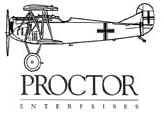|
In the period 1914 to
1918, aerial warfare was transformed from a sporting adventure to
a strategic form of battle that would change forever the way wars
are won and lost. It is probably safe to say that technical
progress in aviation advanced more in these four years than in any
time before or since. Evidence the fact that a purpose-built
fighter did not even exist when hostilities broke out in
1914. Opposing parties took to the air in anything with
wings.
A young,
self-promoting Dutchman named Anthony Fokker saw unlimited
opportunities in this new realm of flight and wasted no time
selling himself and his ideas to the highest bidder. It
seems odd today that Germany, in wartime, would go outside her
borders to secure the talent needed to gain air superiority, but
these were desperate times.
One of the first
technological breakthroughs credited to Fokker was the
synchronized machine gun. Fokker wasted little time in
mounting his newly discovered firepower to the cowl of his E-type
monoplane. The nimble, single-seat Fokker's impact was quick
and severe for the Allies. Many future aces like Von
Richthofen, Udet, and Immelmann got their start in the
"Eindecker" and, along with other German pilots, quickly
gained air superiority for the first time in the war.
The decision to
produce the EIII in model form was an easy one. Its
historical significance was reason enough but there were numerous
technical challenges that we were anxious to meet. The first
was the challenge of modeling a fuselage that was originally
fabricated in tubular steel. Because many of our models are
built and left uncovered, this part of the airframe had to be
"right". Since tubular was out of the questions,
we chose hardwood dowel as a material modelers could work with and
achieve excellent results. We painted our fuselage a light
gray, and it looks great.
The Second was the use
of a fully-functional wing warping system. It is one of the
highlights of the model and a great topic of conversation!
You will be introduced
to the model by four sheets of detailed plans and a 49-page
construction manual. Maple longerons, reed wing tips and
control surfaces are pre-formed and ready for assembly. Most
wood parts are cut, shaped, and sanded for your convenience.
The metal parts are
equally impressive. The scale landing gear features a unique
shock arm system mounted within the fuselage. These
components, along with the tubular tailskid and cabane assembly,
are beautifully fabricated and ready for installation.
All rigging and
control cables, control horns, wing fittings, operable
turnbuckles, spun aluminum cowl, and Spandau machine gun
are included.
While often
overlooked, Fokker's "Eindecker" remains unique to this
day. If you are looking for a new challenge, as we were,
give it a try. We guarantee you'll enjoy it, warped wings
and all !
Click
here to see
more Fokkder "Eindecker" photos in the Photo Gallery
|
